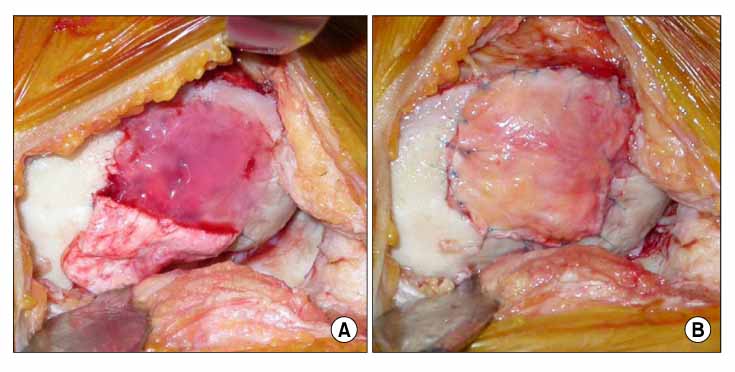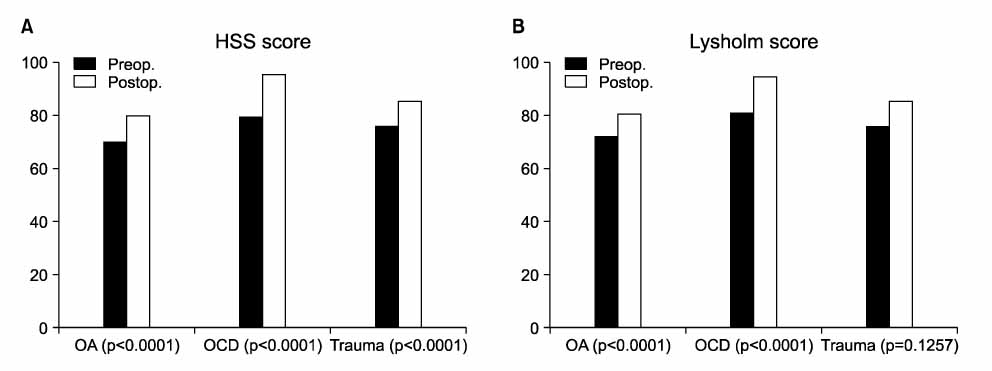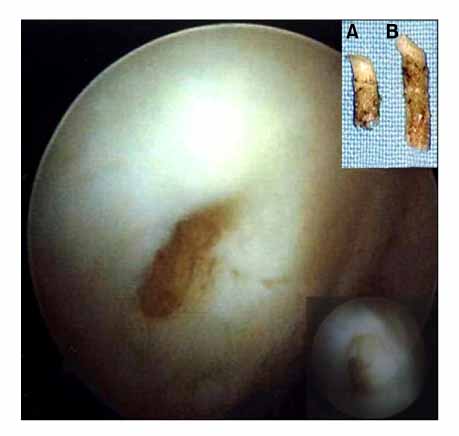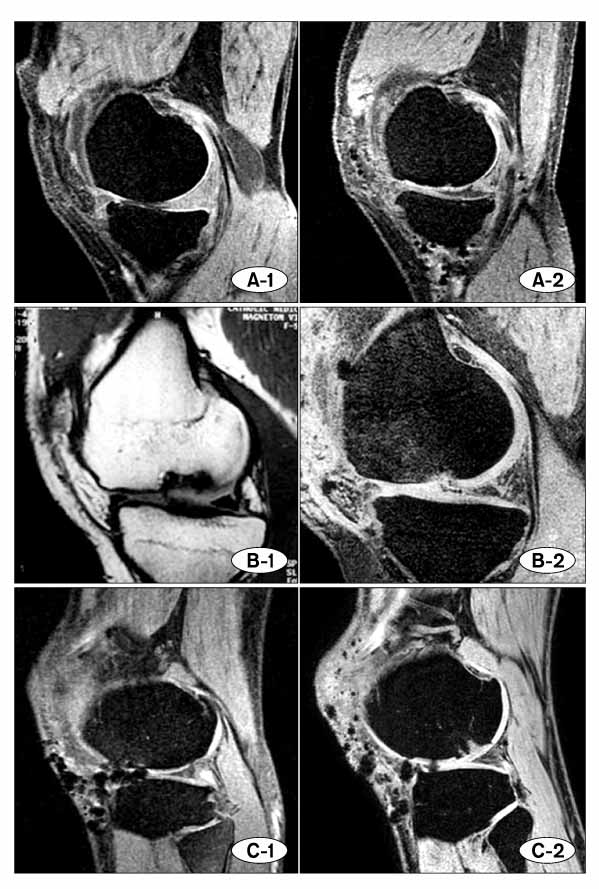J Korean Orthop Assoc.
2009 Apr;44(2):210-218.
Autologous Chondrocyte Implantation for Articular Cartilage Defect of Femoral Condyle
- Affiliations
-
- 1Department of Orthopaedic Surgery, Seoul St. Mary's Hospital, The Catholic University of Korea College of Medicine, Seoul, Korea. osjmk@korea.com
Abstract
- PURPOSE
To evaluate the midterm clinical and histological results after autologous chondrocyte implantation (ACI) for an articular cartilage defect of the distal femoral condyle. MATERIALS AND METHODS: Twenty four cases with an articular cartilage defect (Outerbridge grade IV) of the femoral condyle that was confirmed by MRI and the arthroscopic findings underwent ACI. Their mean age at the time of surgery was 42.8 years and the mean follow-up period was 53.2 months (range, 20-82 months). At the last follow up, the articular cartilage view (SPGR) of MRI was examined and the clinical results were evaluated using the HSS and Lysholm scores. In 8 cases, second-look arthroscopy and biopsy were performed and evaluated using histological and histochemical methods. RESULTS: All cases except for one showed well-regenerated articular cartilage on MRI. All cases showed significant clinical improvement in the HSS and Lysholm scores (p<0.0001), with the exception of the Lysholm score of an articular cartilage fracture. Histologically, the regenerated tissue appeared to be a hyaline-like cartilage in all specimens. CONCLUSION: ACI for the treatment of articular cartilage defects of the distal femoral condyle showed a good clinical and MRI results. In OA, the clinical results were relatively acceptable after an associated high tibial valgus osteotomy. However, a longer term follow-up study will be needed to reach a final conclusion.
Figure
Reference
-
1. Binazzi R, Soudry M, Mestriner LA, Insall JN. Knee arthroplasty rating. J Arthroplasty. 1992. 7:145–148.
Article2. Brittberg M, Lindahl A, Nilsson A, Ohlsson C, Isaksson O, Peterson L. Treatment of deep cartilage defects in the knee with autologous chondrocyte transplantation. N Engl J Med. 1994. 331:889–895.
Article3. Brittberg M, Winalski CS. Evaluation of cartilage injuries and repair. J Bone Joint Surg Am. 2003. 85:Supple 2. S58–S69.
Article4. Brown WE, Potter HG, Marx RG, Wickiewicz TL, Warren RF. Magnetic resonance imaging appearance of cartilage repair in the knee. Clin Orthop Relat Res. 2004. 422:214–223.
Article5. Choi SW, Park SW, Oh IS, et al. Second look arthroscopic finding after fibrin matrix autologous chondrocyte implantation for the treatment of articular cartilage defect of the knee -Preliminary report-. J Korean Arthro Soc. 2007. 11:1–6.6. Curl WW, Krome J, Gordon ES, Rushing J, Smith BP, Poehling GG. Cartilage injuries: a review of 31,516 knee arthroscpoies. Arthroscopy. 1997. 13:456–460.7. Fu FH, Zurakowski D, Browne JE, et al. Autologous chonderocyte implantation versus debridement for treatment of full-thickness chondral defects of the knee: an observational cohort study with 3-year follow-up. Am J Sports Med. 2005. 33:1658–1666.8. Grande DA, Pitman MI, Peterson L, Menche D, Klein M. The repair of experimentally produced defects in rabbit articular cartilage by autologous chondrocyte transplantation. J Orthop Res. 1989. 7:208–218.
Article9. Hangody L, Füles P. Autologous osteochondral mosaicplasty for the treatment of full-thickness defects of weight-bearing joints: ten years of experimental and clinical expreience. J Bone Joint Surg Am. 2003. 85:Suppl. S25–S32.10. Henderson IJ, Tuy B, Connell D, Oakes B, Hettwer WH. Prospective clinical study of autologous chondrocyte implantation and correlation with MRI at three and 12 months. J Bone Joint Surg Br. 2003. 85:1060–1066.
Article11. Hjelle K, Solheim E, Strand T, Muri R, Brittberg M. Articular cartilage defects in 1,000 knee arthroscopies. Arthroscopy. 2002. 18:730–734.
Article12. Kajitani K, Ochi M, Uchio Y, et al. Role of the periosteal flap in chondrocyte transplantation: an experimental study in rabbits. Tissue Eng. 2004. 10:331–342.
Article13. Knutsen G, Engebretsen L, Ludvigsen TC, et al. Autologous chondrocyte implantation compared with microfracture in the knee. A randomized trial. J Bone Joint Surg Am. 2004. 86:455–464.14. Koshino T, Wada S, Ara Y, Saito T. Regeneration of degenerated articular cartilage after high tibial valgus osteotomy for medial compartmental osteoarthritis of the knees. Knee. 2003. 10:229–236.15. Lysholm J, Gillquist J. Evaluation of knee ligament surgery results with special emphasis on use of a scoring scale. Am J Sports Med. 1982. 10:150–154.
Article16. Minas T. Autologous chondrocyte implantation in the arthritic knee. Orthopedics. 2003. 26:945–947.
Article17. Minas T, Peterson L. Advanced techniques in autologous chondrocyte transplantation. Clin Sports Med. 1999. 18:13–44.
Article18. Nehrer S, Domayer S, Dorotka R, Schatz K, Bindreiter U, Kotz R. Three-year clinical outcome after chondrocyte transplantation using a hyaluronan matrix for cartilage repair. Euro J Radio. 2006. 57:3–8.
Article19. Nehrer S, Spector M, Minas T. Histologic analysis of tissue after failed cartilage repair procedures. Clin Orthop Relat Res. 1999. 365:149–162.
Article20. Outerbridge RE. The etiology of chondromalacia patellae. J Bone Joint Surg Br. 1961. 43:752–757.
Article21. Peterson L, Minas T, Brittberg M, Lindahl A. Treatment of osteochondritis dissecans of the knee with autologous chondrocyte transplantation: results at two to ten years. J Bone Joint Surg Am. 2003. 85:Suppl 2. S17–S24.22. Peterson L, Minas T, Brittberg M, et al. Two- to 9-year outcome after autologous chondrocyte transplantation of the knee. Clin Orthop Relat Res. 2000. 374:212–234.
Article23. Polster J, Recht M. Postoperative MR evaluation of chondral repair in the knee. Eur J Radi. 2005. 54:206–213.
Article24. Recht M, Bobic V, Burstein D, et al. Magnetic resonance imaging of articular cartilage. Clin Orthop Relat Res. 2001. 391:379–396.
Article25. Steinwachs M, Kreuz PC. Autologous chondrocyte implantation in chondral defects of the knee with a type I/III collagen membrane: A prospective study with a 3-year follow-up. Arthroscopy. 2007. 23:381–387.26. Vasara AI, Nieminen MT, Jurvelin JS, Peterson L, Lindahl A, Kiviranta I. Indentation stiffness of repair tissue after autologous chondrocyte transplantation. Clin Orthop Relat Res. 2005. 433:233–242.27. Visna P, Adler J, Pasa L, Kocis J, Cizmar I, Horky D. Autologous chondrocyte transplantation for the treatment of articular defects of the knee. Scripta Medica (BRNO). 2003. 76:241–250.
- Full Text Links
- Actions
-
Cited
- CITED
-
- Close
- Share
- Similar articles
-
- Autogeous Bone-Articular Cartilage stored within Abdominal Wall
- Bilateral Osteochondritis Dissecans of the Femoral Condyles in Both Knees: A Report of Two Sibling Cases
- Autologous Chondrocyte Implantation for Treating Chondral Defects of the Femoral Condyle
- Current Concepts in the Articular Cartilage Repair
- Repair of Osteochondral Defect Using Grafts of Cultured Chondrocytes in Rabbits






